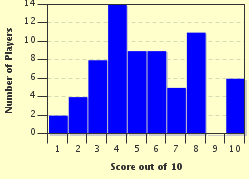Quiz Answer Key and Fun Facts
1. Snow White
2. Rapunzel
3. Belle (from "Beauty and the Beast")
4. Cinderella (Charles Perrault's version)
5. The Little Mermaid
6. Sleeping Beauty (Grimm Brothers' version)
7. Princess Trognon (by Madame d'Aulnoy)
8. Princess Aimee (by Madame d'Aulnoy)
9. "The Princess and the _____" (by Hans Christian Andersen)
10. Cinderella (Grimm Brothers' version)
Source: Author
Ceduh
This quiz was reviewed by FunTrivia editor
looney_tunes before going online.
Any errors found in FunTrivia content are routinely corrected through our feedback system.

